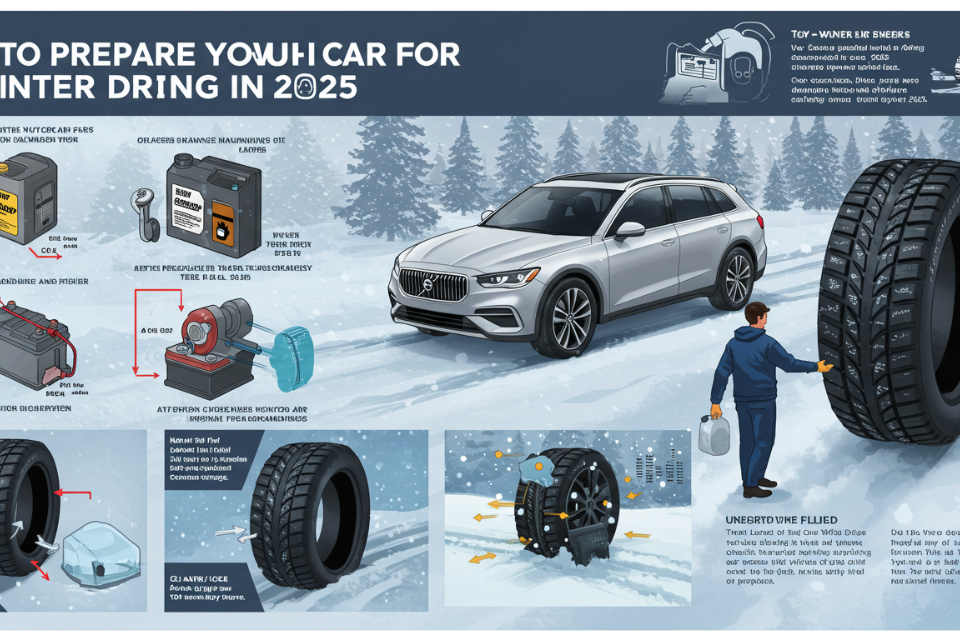Winter driving presents unique challenges, but with the right preparation, you can navigate snowy and icy roads safely and confidently. This guide will equip you with the knowledge and steps to winterize your car and ensure a smooth ride throughout the colder months of 2025.
Checking Your Fluids
Before the first snowflake falls, it’s crucial to check and top off all your vehicle’s essential fluids. This includes engine oil, coolant, brake fluid, power steering fluid, and windshield washer fluid. Using the correct winter-grade fluids is vital, as they are formulated to withstand freezing temperatures. Learn more about winter-grade fluids here.
Battery Health
Cold weather significantly impacts battery performance. A weak battery is more likely to fail in winter. Have your battery tested at an auto parts store or mechanic to ensure it can handle the cold. Consider replacing it if it’s nearing the end of its lifespan. Cold-cranking amps (CCA) are an important rating to check; higher CCAs mean better performance in low temperatures. Read more about battery care.
Tire Tread and Pressure
Proper tire inflation is crucial year-round, but especially in winter. Under-inflated tires reduce traction and fuel efficiency, making winter driving even more dangerous. Check your tire pressure regularly using a reliable gauge and adjust as needed. Additionally, ensure your tires have adequate tread depth for optimal grip on snow and ice. Consider using winter tires for superior performance in snowy conditions. Find out more about tire pressure.
Lights and Visibility
Winter weather often reduces visibility significantly. Ensure all your vehicle’s lights are functioning correctly, including headlights, taillights, brake lights, and turn signals. Clean your headlights and taillights regularly to maximize their effectiveness. Consider investing in high-intensity bulbs for better illumination. See our guide on improving visibility.

Emergency Kit Essentials
Always keep a well-stocked emergency kit in your car during winter. This kit should include items like a flashlight, jumper cables, blankets, gloves, a first-aid kit, non-perishable food, water, and a shovel. Knowing how to use these items is just as important as having them. Check out this emergency kit checklist.
Wiper Blades and Windshield Washer Fluid
Winter often brings snow, sleet, and freezing rain, making clear visibility challenging. Ensure your wiper blades are in good condition and replace them if they are worn or streaked. Use a high-quality winter-grade windshield washer fluid that won’t freeze. Frozen washer fluid can render your wipers useless, severely impacting visibility.
Brakes and Steering
Before winter hits, it’s a good idea to have your brakes and steering system inspected by a mechanic. Ensure your brakes are in optimal condition and your steering is responsive. Winter driving often requires more precise braking and steering, so well-maintained systems are essential for safety. Learn more about winter brake safety.
Conclusion
Preparing your car for winter driving is an investment in your safety and peace of mind. By taking these preventative steps, you’ll be well-equipped to handle whatever winter throws your way. Remember, regular maintenance and preparedness are key to safe and stress-free winter driving.
Frequently Asked Questions
What kind of oil should I use in winter? Use a winter-grade motor oil, as indicated in your vehicle’s owner’s manual. These oils are formulated to flow freely even in cold temperatures.
How do I jump-start my car in freezing weather? Be cautious, and always follow the proper safety precautions when using jumper cables. Never let the jumper cables touch each other. Consult your vehicle’s manual for specific instructions.
When should I switch to winter tires? It’s generally recommended to switch to winter tires when temperatures consistently drop below 7°C (45°F). However, consider local weather conditions and driving habits when making your decision.
What should I do if I get stuck in the snow? Stay calm and remain in your vehicle. If possible, clear snow away from the exhaust pipe and attempt to gently rock the car free. If you’re unable to free yourself, call for roadside assistance.



